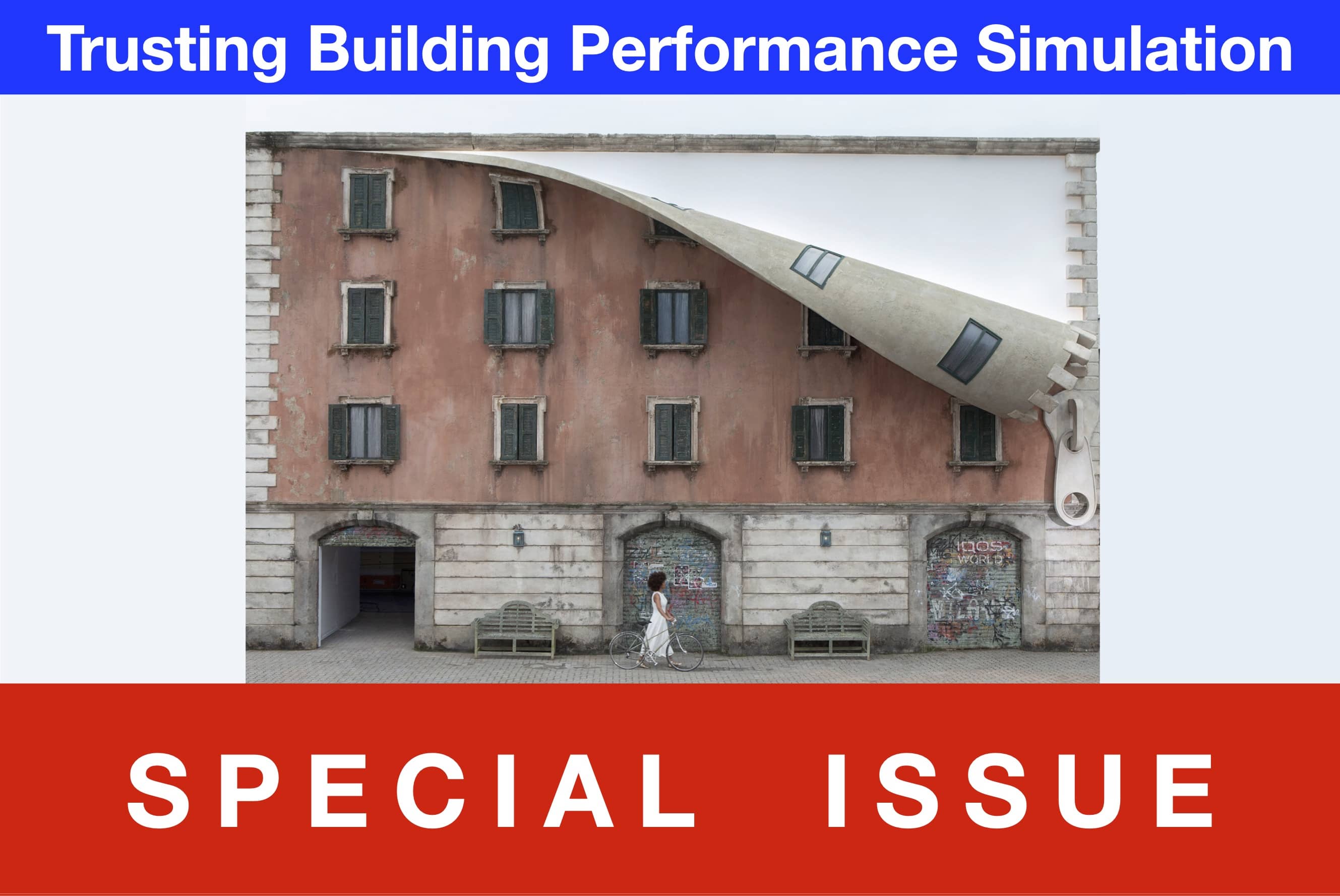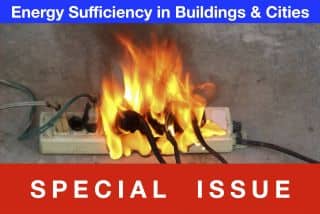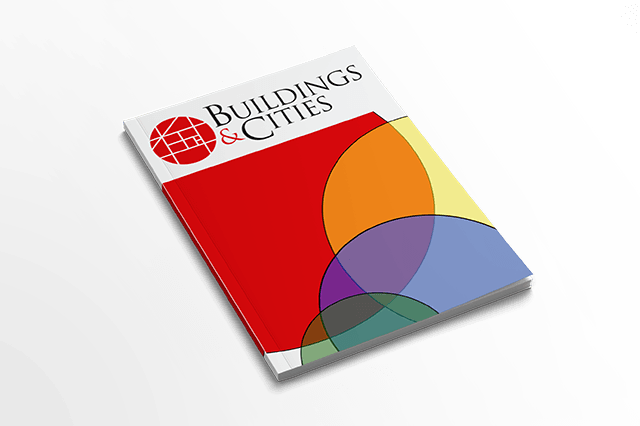
www.buildingsandcities.org/journal-content/special-issues/trusting-building-performance-simulation2.html
Trusting Building Performance Simulation

As codes and regulations become stricter, is simulation the right tool for compliance as well as sketching performance to assist design?
This special issue examines whether building performance simulations can be trusted for their accuracy and reliability. An increasing urgency exists to provide a prediction of performance over the next 50-100 years. As carbon limits become more fixed on absolute performance, a consensus is needed on how to examine performance reliably and accurately – both for new buildings as well as interventions in existing buildings. Several different concerns are addressed pertaining to the building performance gap - particularly practices and expectations.
This special issue reports on quality assurance measures, case studies, user studies that address the development of trust in the performance calculations of designers. The performance gap is not only a problem of inaccurate models, but is partly a result of misguided expectations of what building performance simulation (BPS) tools can predict. As BPS outputs are the result of models that are approximations of reality, building codes need more appropriate performance metrics that test the robustness or reliability of performance, not compliance with some mythical ‘typical’ performance number.
The value of models is to ensure that time and money are not being invested on issues with little benefit to building occupants or investors. BPS has the potential to provide very detailed information that could allow code officials to quantity the risk that buildings might perform in a different manner than has been modelled. In order to achieve this goal, simulation experts need to be far more engaged with definition of and compliance with building energy performance. In addition, experts need to articulate these issues more clearly in order to manage expectations.
Guest editor: Michael Donn
Table of contents
Simulation and the building performance gap [editorial]
M. Donn
Building performance simulation for sense-making in architectural pedagogy
M. Bohm
Metrics for building component disassembly potential: a practical framework
H. Järvelä, A. Lehto, T. Pirilä & M. Kuittinen
Quantifying inter-dwelling air exchanges during fan pressurisation tests
D. Glew, F. Thomas, D. Miles-Shenton & J. Parker
Understanding shading through home-use experience, measurement and modelling
M. Baborska-Narożny, K. Bandurski & M. Grudzińska
Modelling site-specific outdoor temperature for buildings in urban environments
K. Cebrat, J. Narożny, M.
Baborska-Narożny & M. Smektała
Latest Peer-Reviewed Journal Content
Designing for pro-environmental behaviour change: the aspiration–reality gap
J Simpson & J Uttley
Lifetimes of demolished buildings in US and European cities
J Berglund-Brown, I Dobie, J Hewitt, C De Wolf & J Ochsendorf
Expanding the framework of urban living labs using grassroots methods
T Ahmed, I Delsante & L Migliavacca
Youth engagement in urban living labs: tools, methods and pedagogies
N Charalambous, C Panayi, C Mady, T Augustinčić & D Berc
Co-creating urban transformation: a stakeholder analysis for Germany’s heat transition
P Heger, C Bieber, M Hendawy & A Shooshtari
Placemaking living lab: creating resilient social and spatial infrastructures
M Dodd, N Madabhushi & R Lees
Church pipe organs: historical tuning records as indoor environmental evidence
B Bingley, A Knight & Y Xing
A framework for 1.5°C-aligned GHG budgets in architecture
G Betti, I Spaar, D Bachmann, A Jerosch-Herold, E Kühner, R Yang, K Avhad & S Sinning
Net zero retrofit of the building stock [editorial]
D Godoy-Shimizu & P Steadman
Co-learning in living labs: nurturing civic agency and resilience
A Belfield
The importance of multi-roles and code-switching in living labs
H Noller & A Tarik
Researchers’ shifting roles in living labs for knowledge co-production
C-C Dobre & G Faldi
Increasing civic resilience in urban living labs: city authorities’ roles
E Alatalo, M Laine & M Kyrönviita
Co-curation as civic practice in community engagement
Z Li, M Sunikka-Blank, R Purohit & F Samuel
Preserving buildings: emission reductions from circular economy strategies in Austria
N Alaux, V Kulmer, J Vogel & A Passer
Urban living labs: relationality between institutions and local circularity
P Palo, M Adelfio, J Lundin & E Brandão
Living labs: epistemic modelling, temporariness and land value
J Clossick, T Khonsari & U Steven
Co-creating interventions to prevent mosquito-borne disease transmission in hospitals
O Sloan Wood, E Lupenza, D M Agnello, J B Knudsen, M Msellem, K L Schiøler & F Saleh
Circularity at the neighbourhood scale: co-creative living lab lessons
J Honsa, A Versele, T Van de Kerckhove & C Piccardo
Positive energy districts and energy communities: how living labs create value
E Malakhatka, O Shafqat, A Sandoff & L Thuvander
Built environment governance and professionalism: the end of laissez-faire (again)
S Foxell
Co-creating justice in housing energy transitions through energy living labs
D Ricci, C Leiwakabessy, S van Wieringen, P de Koning & T Konstantinou
HVAC characterisation of existing Canadian buildings for decarbonisation retrofit identification
J Adebisi & J J McArthur
Simulation and the building performance gap [editorial]
M Donn
Developing criteria for effective building-sector commitments in nationally determined contributions
P Graham, K McFarlane & M Taheri
Join Our Community

The most important part of any journal is our people – readers, authors, reviewers, editorial board members and editors. You are cordially invited to join our community by joining our mailing list. We send out occasional emails about the journal – calls for papers, special issues, events and more.
We will not share your email with third parties. Read more



Latest Commentaries
COP30 Report
Matti Kuittinen (Aalto University) reflects on his experience of attending the 2025 UN Conference of the Parties in Belém, Brazil. The roadmaps and commitments failed to deliver the objectives of the 2025 Paris Agreement. However, 2 countries - Japan and Senegal - announced they are creating roadmaps to decarbonise their buildings. An international group of government ministers put housing on the agenda - specifying the need for reduced carbon and energy use along with affordability, quality and climate resilience.
Building-Related Research: New Context, New Challenges
Raymond J. Cole (University of British Columbia) reflects on the key challenges raised in the 34 commissioned essays for Buildings & Cities 5th anniversary. Not only are key research issues identified, but the consequences of changing contexts for conducting research and tailoring its influence on society are highlighted as key areas of action.